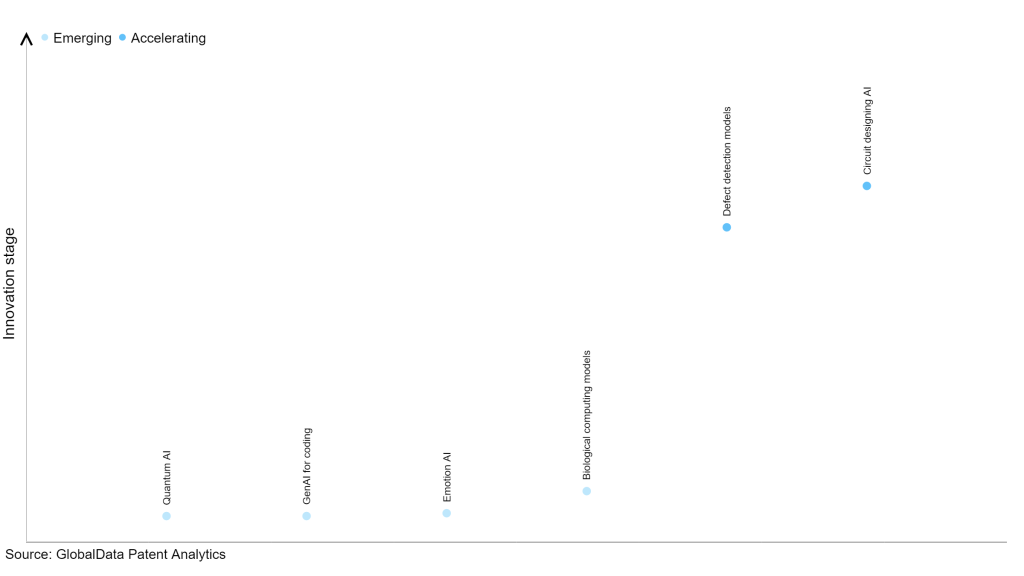The technology industry continues to be a hotbed of patent innovation. Activity is driven by the increasing demand for efficient and automated solutions in sectors such as logistics, agriculture, and surveillance, and regulatory frameworks facilitating expanded drone applications. The growing importance of technologies such as computer vision, simultaneous localization and mapping (SLAM), and reinforcement learning are further fueling the growth of artificial intelligence (AI) integration in drone controls. In the last three years alone, there have been over 1.5 million patents filed and granted in the technology industry, according to GlobalData’s report on Artificial intelligence in technology: drone controls AI. Buy the report here.

Access deeper industry intelligence
Experience unmatched clarity with a single platform that combines unique data, AI, and human expertise.
However, not all innovations are equal and nor do they follow a constant upward trend. Instead, their evolution takes the form of an S-shaped curve that reflects their typical lifecycle from early emergence to accelerating adoption, before finally stabilizing and reaching maturity.
Identifying where a particular innovation is on this journey, especially those that are in the emerging and accelerating stages, is essential for understanding their current level of adoption and the likely future trajectory and impact they will have.
185+ innovations will shape the technology industry
According to GlobalData’s Technology Foresights, which plots the S-curve for the technology industry using innovation intensity models built on over 1.6 million patents, there are 185+ innovation areas that will shape the future of the industry.
Within the emerging innovation stage, quantum AI, GenAI for coding and emotion AI are disruptive technologies that are in the early stages of application and should be tracked closely. Biological computing models, defect detection models, and circuit designing AI are some of the accelerating innovation areas, where adoption has been steadily increasing industry.
Innovation S-curve for artificial intelligence in the technology industry

Drone controls AI is a key innovation area in artificial intelligence
AI in drone controls involves the utilization of sophisticated control systems and artificial intelligence to guide and manage drones. This advancement enables drones to execute tasks independently, including functions like avoiding obstacles, charting courses, and executing missions, all without the need for human intervention.
GlobalData’s analysis also uncovers the companies at the forefront of each innovation area and assesses the potential reach and impact of their patenting activity across different applications and geographies. According to GlobalData, there are 140+ companies, spanning technology vendors, established technology companies, and up-and-coming start-ups engaged in the development and application of drone controls AI.
Key players in drone controls AI – a disruptive innovation in the technology industry
‘Application diversity’ measures the number of applications identified for each patent. It broadly splits companies into either ‘niche’ or ‘diversified’ innovators.
‘Geographic reach’ refers to the number of countries each patent is registered in. It reflects the breadth of geographic application intended, ranging from ‘global’ to ‘local’.
Among the companies innovating in AI in drone controls, DJI Technology is one of the leading patents filers. The company’s patents are aimed at developing techniques and systems for adjusting the independent flight of one or more unmanned aerial vehicles (UAVs). In certain scenarios, the UAV's autonomous flight can be initiated by a user input at the first user interface. Subsequently, a second user input received at the second user interface may alter the autonomous flight while still retaining its autonomous capabilities. This adjustment occurs throughout the duration of the second user input, aimed at assisting the user and modifying the UAV's autonomous flight. The other prominent patent filers in the space include Nuro and Sony Group.
In terms of application diversity, DJI Technology leads the pack, while Halliburton and GoPro stood in the second and third positions, respectively. By means of geographical reach, Nuro held the top position, followed by Proxy Technologies and Halliburton.
AI integration in drone controls enables drones to operate autonomously, performing complex tasks without constant human intervention. This capability is crucial in industries like agriculture, where drones can autonomously survey fields, monitor crop health, and apply treatments. Additionally, AI-powered drone controls enhance safety by enabling obstacle detection and avoidance, reducing the risk of accidents.
To further understand the key themes and technologies disrupting the technology industry, access GlobalData’s latest thematic research report on Artificial Intelligence (AI).
Data Insights
From

The gold standard of business intelligence.
Blending expert knowledge with cutting-edge technology, GlobalData’s unrivalled proprietary data will enable you to decode what’s happening in your market. You can make better informed decisions and gain a future-proof advantage over your competitors.







